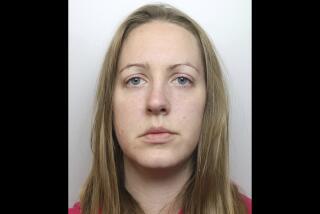Case of Babies’ Killer Is Like None Other
- Share via
Philadelphia investigators have been waiting for decades to hear Marie Noe get up in open court and admit that she smothered eight of her babies back in the ‘40s, ‘50s and ‘60s. But since the 70-year-old woman made that startling public confession in a small courtroom --pleading guilty to eight counts of second-degree murder--while her 77-year-old husband, Arthur, wept in the gallery, there has been a torrent of international criticism of the plea bargain that led to it.
What most people have heard about her sentence is this: For killing eight children, Marie Noe got 20 years’ probation, the first five to be served under house arrest. Given such limited information, the public outcry is predictable. After all, what kind of message does a big-city D.A. send by letting the perpetrator in the largest case of maternal infanticide in American history walk without jail time, when so many one-time murderers sit on death row?
But it’s a mistake to compare the Noe situation to a standard capital murder case, or pass judgment based only on the sound bite. The case against Marie Noe sat dormant for 30 years because suspicious medical examiner investigators were unable to persuade police to move forward in what would have been, given the science of the day, an extremely risky prosecution with no physical evidence.
There are really only two or three cases even remotely like this one: The best known are Waneta Hoyt in Syracuse and Mary Beth Tinning in Schenectady, both of which were multiple infant deaths initially attributed to sudden infant death syndrome but later revealed as murders. Both mothers forced prosecutors into long, painful, expensive circus trials, and both ended up spending the rest of their lives in prison. But the Hoyt and Tinning children died in the ‘70s and ‘80; Marie Noe’s first child was smothered in 1949. And neither Hoyt nor Tinning had been so extensively investigated--and exonerated--at the time of the children’s deaths. A trial for Marie Noe was by no means a slam dunk; it could have been a debacle.
Even more important to consider, though, is the third part of the Noe plea bargain, which so far has received little attention even though it could turn out to be the most controversial and dramatic aspect of the sentence. In exchange for her plea, Marie Noe agreed to be extensively examined by court-appointed psychiatric experts, so that her case might promote a better understanding of infanticide and the post-partum illnesses that appear to have contributed to the murders. The money that would have been used to prosecute and jail her is supposed to be used to fund this.
Marie Noe has a long and well-documented history of mental illness, so it wouldn’t have been unusual for a sentence to include some kind of forced treatment. Instead, she faces this radical alternative, which the district attorneys admit is unprecedented. Marie has agreed, basically, to become a real-time teaching case--to donate her brain to science before death--for the public good.
At the very least, this could put an end to all the current armchair speculation about what is wrong with her. Some have conjectured she suffers from Munchausen-by-proxy syndrome, in which a parent repeatedly harms a child to get attention from medical workers; others have suggested that she suffers from a dissociative disorder. There has also been a psychoanalytic theory of her actions, and a neurobiological analysis. Unfortunately, none of these has come from anyone who has actually interviewed or met Marie Noe face to face.
If Dist. Atty. Lynne Abraham and her assistant in charge of this prosecution, Charles Gallagher, are smart and creative with the resources they claim they will commit to this research, Marie Noe might be able to shatter some longstanding psychiatric myths about mothers who kill and actually offer some constructive treatments. This opportunity could be fumbled, like, say, the case of Genie, the so-called California “wild child” whose long-term study by linguists yielded almost nothing. Or the promised study could simply fall through the cracks like so many post-sentence promises. While Noe would have gone directly to jail if so sentenced, she did walk out of that courtroom without any real plan in place for her psychiatric future.
That’s why it is important for the public to keep paying attention to the case. If it isn’t honestly carried out, then the Marie Noe sentence really could become the miscarriage of justice that many already think it is.
More to Read
Sign up for Essential California
The most important California stories and recommendations in your inbox every morning.
You may occasionally receive promotional content from the Los Angeles Times.












